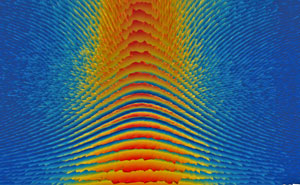Mar. 23, 2018 Research Highlight Computing / Math Physics / Astronomy
Reducing noise in silicon quantum dots boosts calculation precision
The quantum equivalents of computer bits can be manipulated quicker and more precisely by using techniques that liberate them from intrinsic ‘hyperfine noise’
 Figure 1: Spins in a quantum dot device can be manipulated millions of times per second with electronic pulses and micro-magnetic fields; the orange peaks represent the probability of seeing a spin-up state over microsecond time frames. © 2018 RIKEN Center for Emergent Matter Science
Figure 1: Spins in a quantum dot device can be manipulated millions of times per second with electronic pulses and micro-magnetic fields; the orange peaks represent the probability of seeing a spin-up state over microsecond time frames. © 2018 RIKEN Center for Emergent Matter Science
Using ultrapure crystals of silicon and micromagnets, RIKEN researchers have demonstrated enhanced electrical control over the directions in which electron spins point inside tiny boxes in silicon called quantum dots1. This approach, which operates quantum logic gates with 99.9 per cent precision, offers an attractive pathway for manufacturing fault-tolerant quantum computers on a large scale.
Quantum bits, or ‘qubits’, exploit quantum superposition states to generate far higher computational powers than conventional semiconductor circuits. Electron spins are leading candidates for such qubits, which can be implemented in structures similar to today’s computing devices.
To perform practical numbers of computing operations, these spin qubits need to maintain the superposition of ‘up’ and ‘down’ spin orientations for extended times—a property known as coherence. Unfortunately, these spin states are highly sensitive to magnetic noise from surrounding atoms, such as those on silicon chips.
“In this kind of semiconductor nanodevice, a single electron is typically coupled to thousands of other nuclei, which can degrade the spin coherence,” explains Jun Yoneda of the RIKEN Center for Emergent Matter Science. “Even though 95 per cent of the nuclei in silicon don’t interfere, the remaining nuclear spins are the dominant source of noise in our qubits.”
Yoneda and colleagues in Seigo Tarucha’s group are seeking to improve qubit circuit performance by mitigating magnetic contamination. One way they are achieving this is by ensuring atoms inside their silicon chips are all the same isotope—that is, they all have the same number of neutrons in their nuclei. This procedure reduces magnetic noise sources to less than 0.08 per cent. However, orienting spins in ultrapure samples is time consuming because the coherent states are so isolated from the electromagnetic environment.
To direct spin more effectively, the researchers fabricated quantum dots on isotopically pure silicon and then used tiny micromagnets to introduce magnetic fields in specific lateral and perpendicular directions across the dot. By applying a series of phase-corrected electrical pulses along the magnetic fields, they coupled the control hardware to a single electron spin and switched its orientation at rates of up to 30 million times per second (Fig. 1). Experiments with qubit logic gates revealed the new spin–electric coupling procedure reduced quantum computing error rates to record low levels.
The residual noise in the system came from random fluctuations in charge—a finding that contradicts previous observations about spin coherence. “This is surprising because a single electron spin is much more sensitive to magnetic environments than electric ones,” says Yoneda. “But it comes from having enhanced coherence and controllability, and it points to future improvements by using established routines to reduce charge noise.”
Related contents
- Exotic quantum technology realized using normal silicon
- Joining the dots for quantum computing
- Quantum information finds its edge
References
- 1. Yoneda, J., Takeda, K., Otsuka, T., Nakajima, T., Delbecq, M. R., Allison, G., Honda, T., Kodera, T., Oda, S., Hoshi, Y. et al. A quantum-dot spin qubit with coherence limited by charge noise and fidelity higher than 99.9%. Nature Nanotechnology 13, 102–106 (2018). doi: 10.1038/s41565-017-0014-x
